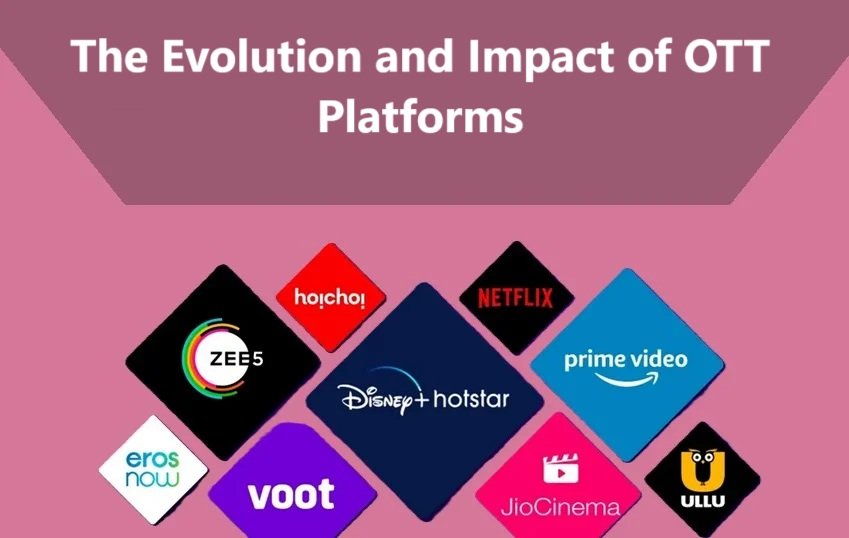
The Evolution and Impact of OTT Platforms
In recent years, Over-The-Top (OTT) platforms have revolutionized the way we consume entertainment. These platforms, which deliver content directly to viewers via the internet, have disrupted traditional media like television and cinema, offering unparalleled convenience, diversity, and personalization.
The Rise of OTT Platforms
The emergence of OTT platforms can be traced back to the early 2000s, with the advent of broadband internet and the growing accessibility of digital devices. Companies like Netflix, which started as a DVD rental service, transitioned to streaming in 2007, marking a pivotal moment in the industry. Soon after, other players like Hulu, Amazon Prime Video, and Disney+ joined the fray, creating a competitive landscape that spurred innovation and growth.
In India, the OTT market gained momentum with the launch of platforms like Hotstar (now Disney+ Hotstar), ZEE5, and MX Player. The widespread adoption of smartphones, affordable internet plans, and the increasing availability of regional content further fueled this growth. By 2025, the Indian OTT market is projected to surpass $5 billion, driven by a young, tech-savvy population and a burgeoning appetite for digital entertainment.
Advantages of OTT Platforms
OTT platforms have gained immense popularity due to their numerous advantages:
- Accessibility and Convenience: Unlike traditional cable TV, OTT platforms allow users to watch content anytime, anywhere, as long as they have an internet connection. This flexibility has made OTT services a preferred choice for busy urban audiences.
- Diverse Content Library: From Hollywood blockbusters to indie films, regional cinema, and niche documentaries, OTT platforms cater to a wide array of tastes and preferences. They also offer original programming, which has become a hallmark of platforms like Netflix and Amazon Prime Video.
- Cost-Effectiveness: OTT subscriptions are often more affordable than traditional cable or satellite packages, making them accessible to a broader audience.
- Personalized Experience: Advanced algorithms analyze user preferences to recommend content tailored to individual tastes, enhancing user satisfaction.
Challenges and Concerns
Despite their success, OTT platforms face several challenges:
- Content Regulation: The absence of stringent censorship has sparked debates about the appropriateness of certain content, particularly in culturally sensitive regions like India.
- Competition and Market Saturation: With numerous players in the market, standing out has become increasingly challenging. Platforms must continuously invest in high-quality, exclusive content to retain subscribers.
- Piracy: Digital content is vulnerable to piracy, leading to significant revenue losses for platforms and content creators.
- Digital Divide: While OTT platforms thrive in urban areas, limited internet penetration and digital literacy in rural regions pose barriers to widespread adoption.
The Impact of OTT Platforms
The impact of OTT platforms extends beyond entertainment. They have reshaped the media and entertainment industry, creating new opportunities for content creators, actors, and filmmakers. Regional content, which was often overshadowed by mainstream cinema, has found a global audience, fostering cultural exchange and diversity.
Moreover, OTT platforms have democratized content production and distribution, allowing independent creators to showcase their work without relying on traditional gatekeepers. This shift has empowered creators to experiment with unconventional storytelling, pushing the boundaries of creativity.
The Future of OTT Platforms
The future of OTT platforms looks promising, with advancements in technology and changing consumer behaviors shaping the landscape. Innovations like artificial intelligence, virtual reality, and interactive content are expected to enhance user engagement and redefine the viewing experience.
Furthermore, the integration of e-commerce, live sports streaming, and gaming into OTT platforms could open up new revenue streams and expand their appeal. Partnerships with telecom companies and smart device manufacturers will also play a crucial role in driving growth.
Conclusion
OTT platforms have transformed the entertainment ecosystem, offering unparalleled convenience, choice, and personalization. As they continue to evolve, addressing challenges like content regulation and market saturation will be critical to sustaining their growth. With their ability to adapt to changing consumer demands and technological advancements, OTT platforms are poised to remain at the forefront of digital entertainment for years to come.
Read Also: Best OTT Platforms in India: A Comprehensive Guide






